
 We already have published on this site articles about the observation flights carried out by the British and the French above the Berlin Control Zone aboard small
single-engine airplanes. You are therefore now familiar with the context, the BCZ and the rationale for these amazing missions.
Otherwise, I invite you to read or re-read these articles before continuing: "Safety of
Flight Not Garanteed" (four pages) and "The 'Air Recce' of the FMLM" (two pages).
Reading the second part of the "Border Patrol" page also can help you.
Of course, the Americans were not outdone where this kind of mission was concerned. However, if the organization of the French and British operations was generally similar,
the structure supporting the US intelligence flights and their purpose were very different.
Here is an exclusive summary of Operation Larkspur.
We already have published on this site articles about the observation flights carried out by the British and the French above the Berlin Control Zone aboard small
single-engine airplanes. You are therefore now familiar with the context, the BCZ and the rationale for these amazing missions.
Otherwise, I invite you to read or re-read these articles before continuing: "Safety of
Flight Not Garanteed" (four pages) and "The 'Air Recce' of the FMLM" (two pages).
Reading the second part of the "Border Patrol" page also can help you.
Of course, the Americans were not outdone where this kind of mission was concerned. However, if the organization of the French and British operations was generally similar,
the structure supporting the US intelligence flights and their purpose were very different.
Here is an exclusive summary of Operation Larkspur.
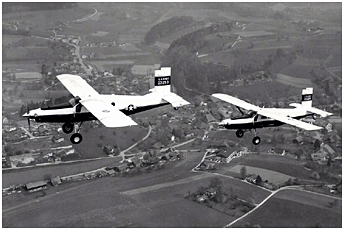
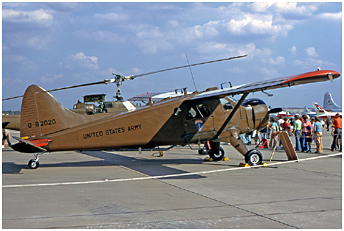 The English and French aerial observers belonged exclusively to their respective military liaison missions, complementing their ground tours with aerial surveillance flights.
These flights also made it possible to better prepare the so-called "local" missions (1) that were carried out in turn by the three allied missions.
Operation Larkspur did not always follow the same criteria for its operation and for good reason. When this operation was set up (probably in 1967), it was not destined to support the US Military
Liaison Mission (USMLM). It was indeed placed under the auspices of the US Command Berlin (USCOB), better known as the "Berlin Brigade."
Thus, USMLM personnel a priori were not taking part in these operations.
It seems that the first aircraft used above the BCZ were DHC L-20A Beaver (designated U-6A after 1962). Cessna L-19A Bird Dog (designated O-1A after 1962) also were assigned to Berlin;
however, we do not know if they were used in intelligence missions over East Berlin. These aircraft were on strength with the "Army Aviation Detachment Berlin Brigade"
better known as the "Aviation Detachment Berlin," based at Berlin Tempelhof Central Airport.
The English and French aerial observers belonged exclusively to their respective military liaison missions, complementing their ground tours with aerial surveillance flights.
These flights also made it possible to better prepare the so-called "local" missions (1) that were carried out in turn by the three allied missions.
Operation Larkspur did not always follow the same criteria for its operation and for good reason. When this operation was set up (probably in 1967), it was not destined to support the US Military
Liaison Mission (USMLM). It was indeed placed under the auspices of the US Command Berlin (USCOB), better known as the "Berlin Brigade."
Thus, USMLM personnel a priori were not taking part in these operations.
It seems that the first aircraft used above the BCZ were DHC L-20A Beaver (designated U-6A after 1962). Cessna L-19A Bird Dog (designated O-1A after 1962) also were assigned to Berlin;
however, we do not know if they were used in intelligence missions over East Berlin. These aircraft were on strength with the "Army Aviation Detachment Berlin Brigade"
better known as the "Aviation Detachment Berlin," based at Berlin Tempelhof Central Airport.
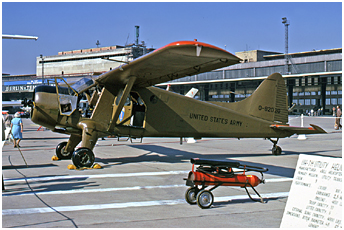
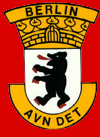 USCOB ran the Larkspur program and provided both the aircraft and the staff. However, in 1974, Colonel Peter Thorsen, recently assigned as Chief, USMLM,
managed to convince the "powers-that-be" that USMLM officers should participate as observers in the Larkspur program. This cooperation was supposed to increase the
effectiveness of intelligence gathering and benefit all parties involved.
The USMLM photo lab could process films overnight, whereas USCOB was taking weeks to process film and delayed reporting.
Captain Nicholas Troyan remembers: « At the time USMLM began participation in Larkspur, rumor had it that the US Army Personnel Directorate only allowed company grade
officers to be assigned to "flight duty" (and receive flight pay), because field grade "pilots" who were not assigned to a "flight slot" had to have approval from DA (Department of the Army)
before being assigned to non-pilot flight duty (2). So the first two officers who were placed on flight duty status were USAF
Captain Orr Y. Potebnya, Jr. (deceased) and Army Captain Nicholas Troyan (yours truly). I was thrilled at having the opportunity to be an observer for Larkspur.
Because Orr was a personal friend, plus a USAF officer, I know he also was very happy with this assignment. For me, it was exciting because, at one time, I had taken private
flying lessons in an "Aeronca" and the newer "Citabria," a single-engine acrobatic aircraft, and had accumulated about 20 hours with an instructor pilot, and 60 hours of solo flying time. »
In 1975-76 there was little coordination with aerial missions flown by the British and the French - this was probably a consequence of
Larkspur program management by USCOB instead of the USMLM. If one of their aircraft was seen over an area or a target, it was not appropriate to invade their airspace for security reasons
nor was it wise to unnecessarily disturb the Soviets or East Germans. However, everyone consulted each other when a target had a particular interest, the cooperation among the military
liaison missions continuing into the air.
USCOB ran the Larkspur program and provided both the aircraft and the staff. However, in 1974, Colonel Peter Thorsen, recently assigned as Chief, USMLM,
managed to convince the "powers-that-be" that USMLM officers should participate as observers in the Larkspur program. This cooperation was supposed to increase the
effectiveness of intelligence gathering and benefit all parties involved.
The USMLM photo lab could process films overnight, whereas USCOB was taking weeks to process film and delayed reporting.
Captain Nicholas Troyan remembers: « At the time USMLM began participation in Larkspur, rumor had it that the US Army Personnel Directorate only allowed company grade
officers to be assigned to "flight duty" (and receive flight pay), because field grade "pilots" who were not assigned to a "flight slot" had to have approval from DA (Department of the Army)
before being assigned to non-pilot flight duty (2). So the first two officers who were placed on flight duty status were USAF
Captain Orr Y. Potebnya, Jr. (deceased) and Army Captain Nicholas Troyan (yours truly). I was thrilled at having the opportunity to be an observer for Larkspur.
Because Orr was a personal friend, plus a USAF officer, I know he also was very happy with this assignment. For me, it was exciting because, at one time, I had taken private
flying lessons in an "Aeronca" and the newer "Citabria," a single-engine acrobatic aircraft, and had accumulated about 20 hours with an instructor pilot, and 60 hours of solo flying time. »
In 1975-76 there was little coordination with aerial missions flown by the British and the French - this was probably a consequence of
Larkspur program management by USCOB instead of the USMLM. If one of their aircraft was seen over an area or a target, it was not appropriate to invade their airspace for security reasons
nor was it wise to unnecessarily disturb the Soviets or East Germans. However, everyone consulted each other when a target had a particular interest, the cooperation among the military
liaison missions continuing into the air.
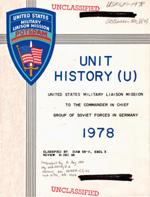 |
USMLM Unit History, 1978 - extract JOINT COLLECTION ACTIVITIES: 1. General. a. Joint Division, supplemented by three enlisted personnel from ODCSI, USCOB, is responsible for USMLM participation in Project LARKSPUR, a USMLM/ODCSI USCOB joint intelligence information collection program covering the BERLIN Control Zone (BCZ), a circle with a 20-mile radius, centered on BERLIN. Warsaw Pact forces garrisoned within the LARKSPUR area of operations include: One Soviet tank division (TD), one Motorized Rifle division (MRD), one Mortorized Rifle regiment (MRR) and one tank regiment (TR) from a second MRD, two brigades from the 34th Gun/Arty Div (GAD) and two MRR of the EGA 1st MRD, as well as ECM, signal and Border Command Central (BCC) units of interest, two military airfields and the East German civilian SCHONEFELD AFLD. LARKSPUR coverage of the BCZ is scheduled for every third day, weather permitting. b. LARKSPUR enjoys one advantage over other USMLM collection program: free access to installations of interest and the consequent opportunity for continuous monitoring ot these installation. Disadvantages include a greater dependence on a favorable weather conditions, an inability to remain for long periods near a target and an inability to bring back documents or materials a la SANDDUNE [collection of material in garbage dumps]. |
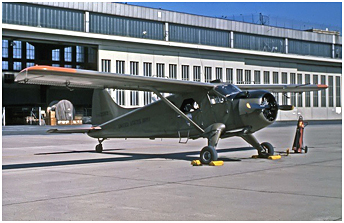
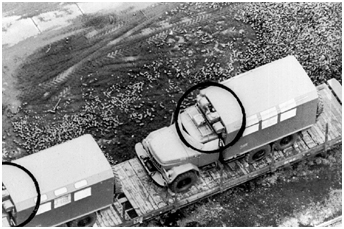 Nicholas Troyan goes on: « I flew with SFC Dennis St. John of the Berlin Brigade. He was the true "expert" on Larkspur, having flown it for a "long time." The pilot was an Army CWO
(Chief Warrant Officer) whose name I cannot recall. However, I do recall that the briefing that I received from SFC St. John on the program was that the aircraft could fly a
40 miles (64km) circle around Berlin, and had to maintain a 1000-foot above ground level (AGL) ceiling. Sitting in the front (co-pilot) seat of the [Beaver] aircraft, I noticed that it
was very difficult to observe, let alone achieve a clear photo, through the front triangular window of the aircraft. SFC St. John sat in the rear, and had a larger window;
however, it also limited his ability to take very clear shots. In my "youthful exuberance," I asked the pilot to remove the right door from the aircraft.
After finding out that the "Sovs" did not have or did not use height finder radar against our program, I had the pilot fly lower than the 1000ft AGL "required."
This, plus the opening with the door removed, allowed both the person in the co-pilot seat and rear-seat occupant to get much clearer shots of activities on the ground.
On one of our flights, as we approached the Dallgow-Döberitz barracks area, we saw what appeared to be the entire tank regiment that had apparently just returned from maneuvers
lined up in front of the vehicle wash ramps. SFC St. John and I also noticed what appeared to be a new version of a BMP (armored personnel carrier). At that moment,
I asked the pilot to let me take the "yoke." »
Nicholas Troyan goes on: « I flew with SFC Dennis St. John of the Berlin Brigade. He was the true "expert" on Larkspur, having flown it for a "long time." The pilot was an Army CWO
(Chief Warrant Officer) whose name I cannot recall. However, I do recall that the briefing that I received from SFC St. John on the program was that the aircraft could fly a
40 miles (64km) circle around Berlin, and had to maintain a 1000-foot above ground level (AGL) ceiling. Sitting in the front (co-pilot) seat of the [Beaver] aircraft, I noticed that it
was very difficult to observe, let alone achieve a clear photo, through the front triangular window of the aircraft. SFC St. John sat in the rear, and had a larger window;
however, it also limited his ability to take very clear shots. In my "youthful exuberance," I asked the pilot to remove the right door from the aircraft.
After finding out that the "Sovs" did not have or did not use height finder radar against our program, I had the pilot fly lower than the 1000ft AGL "required."
This, plus the opening with the door removed, allowed both the person in the co-pilot seat and rear-seat occupant to get much clearer shots of activities on the ground.
On one of our flights, as we approached the Dallgow-Döberitz barracks area, we saw what appeared to be the entire tank regiment that had apparently just returned from maneuvers
lined up in front of the vehicle wash ramps. SFC St. John and I also noticed what appeared to be a new version of a BMP (armored personnel carrier). At that moment,
I asked the pilot to let me take the "yoke." »
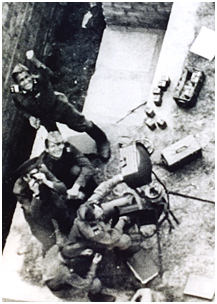
 « I made a hard right bank, relinquished control back to the pilot, and began photographing the equipment around the wash ramp.
At that time, I heard SFC St. John tell me over the intercom that a lens he was changing on his camera had slipped from his hand during my hard banking of the craft, and he
thought it had fallen on top of the "Sovs." He also said we should immediately head back to report this occurrence to HQ. I saw that most of the "Sovs" around the wash ramps were
pointing up at us, some with their AKs. However, this was not unusual, since any time we flew over their installations, the "Sovs" and East Germans would point at us, some would wave,
some shook their fists, and some pointed their weapons. I never saw any of the officers take out their pistols and point them at us during my overflights.
(However, I did experience Soviet officers unholstering and pointing their pistols at us during a few "close call" ground tours. This is significant in that, as far as I knew,
the Soviet officers did carry loaded pistols.) Apparently delaying leaving the area was the correct decision, since within minutes of dropping the camera lens, both [?] a British and
a French version of Larkspur appeared in the area. I heard that the Soviets protested the "bombing," as it was dubbed, to Henry Kissinger via the Soviet ambassador; however,
because of the British and [or] French presence, nobody could verify who had dropped what on the Soviet wash ramp. When we returned to USMLM and I reported to Colonel Thorsen,
his first reaction was: "Troyan, you again, I hope you have your bags packed," or words to that affect; however, SFC St. John saved my hide by saying that it was he who dropped the lens.
At this point then, Colonel Thorsen became very gracious to SFC St. John, stating that, after all the time he had been running this program, the odds that an unforeseen event would
occur was only natural. He told me to accompany SFC St. John to BB and pass on to Colonel Baker, the Berlin Brigade Deputy Chief of Staff for Intelligence, to not be too hard on SFC St. John.
He also ordered me to come up with a Standard Operating Procedure that would ensure that all "lens swapping would be done inside the flight bag, which would be secured to the aircraft seat. »
« I made a hard right bank, relinquished control back to the pilot, and began photographing the equipment around the wash ramp.
At that time, I heard SFC St. John tell me over the intercom that a lens he was changing on his camera had slipped from his hand during my hard banking of the craft, and he
thought it had fallen on top of the "Sovs." He also said we should immediately head back to report this occurrence to HQ. I saw that most of the "Sovs" around the wash ramps were
pointing up at us, some with their AKs. However, this was not unusual, since any time we flew over their installations, the "Sovs" and East Germans would point at us, some would wave,
some shook their fists, and some pointed their weapons. I never saw any of the officers take out their pistols and point them at us during my overflights.
(However, I did experience Soviet officers unholstering and pointing their pistols at us during a few "close call" ground tours. This is significant in that, as far as I knew,
the Soviet officers did carry loaded pistols.) Apparently delaying leaving the area was the correct decision, since within minutes of dropping the camera lens, both [?] a British and
a French version of Larkspur appeared in the area. I heard that the Soviets protested the "bombing," as it was dubbed, to Henry Kissinger via the Soviet ambassador; however,
because of the British and [or] French presence, nobody could verify who had dropped what on the Soviet wash ramp. When we returned to USMLM and I reported to Colonel Thorsen,
his first reaction was: "Troyan, you again, I hope you have your bags packed," or words to that affect; however, SFC St. John saved my hide by saying that it was he who dropped the lens.
At this point then, Colonel Thorsen became very gracious to SFC St. John, stating that, after all the time he had been running this program, the odds that an unforeseen event would
occur was only natural. He told me to accompany SFC St. John to BB and pass on to Colonel Baker, the Berlin Brigade Deputy Chief of Staff for Intelligence, to not be too hard on SFC St. John.
He also ordered me to come up with a Standard Operating Procedure that would ensure that all "lens swapping would be done inside the flight bag, which would be secured to the aircraft seat. »
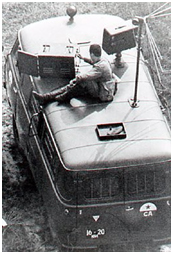
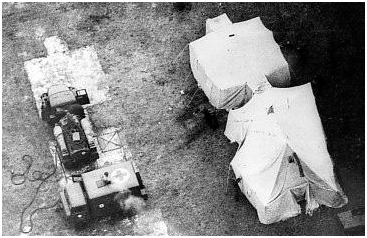 Major Thomas Spencer remembers: « In 1975, a Larkspur observer position become available. I went to Colonel Peter Thorsen, Chief USMLM, and volunteered to extend my tour at USMLM for
one year if I could be the USMLM Larkspur program officer and cease being a ground tour officer. I had undergone pilot training earlier in an older high-wing Aeronca aircraft,
I loved flying, and I knew my two years of ground touring in East Germany had prepared me well for equipment identification, map reading, and the like. Two previous USMLM officers
who worked part-time on LARKSPUR had proven that the combination of proficient USMLM officers with their equipment identification skills and local area familiarity enhanced
that program. The USCOB owned the Larkspur program and its assets (planes and people) and realized that USMLM augmentation made for a more effective intelligence collection effort.
This was a real win-win for the American intelligence aerial collection efforts within the BCZ. Colonel Thorsen approved my request and it was on this basis that I became the first full-time
USMLM Larkspur Officer. A Berlin Brigade NCO, Staff Sgt. St. John, and I flew as aircraft crewmen out of Templehof Airfield. We both studied extant Specific Intelligence Collection
Requirements submitted by various governmental agencies to guide us in our collection efforts, but also never missed an opportunity for targets of opportunity. During our missions,
we wore fire-retardant Nomex flight suits with no insignia to provide some superficial masking of our identities. We did carry our military identification cards in case of having
to land in East Germany. In actuality, we were pretty certain that the Soviets and East Germans knew that what those aboard the Larkspur aircraft were doing. It sometimes felt
ridiculous knowing that the only people who really didn't know the Larkspur program existed were our own American people. But those were some of the games played during the Cold War.
We felt like Pogo, who said: "we have met the enemy, and he is us." »
Major Thomas Spencer remembers: « In 1975, a Larkspur observer position become available. I went to Colonel Peter Thorsen, Chief USMLM, and volunteered to extend my tour at USMLM for
one year if I could be the USMLM Larkspur program officer and cease being a ground tour officer. I had undergone pilot training earlier in an older high-wing Aeronca aircraft,
I loved flying, and I knew my two years of ground touring in East Germany had prepared me well for equipment identification, map reading, and the like. Two previous USMLM officers
who worked part-time on LARKSPUR had proven that the combination of proficient USMLM officers with their equipment identification skills and local area familiarity enhanced
that program. The USCOB owned the Larkspur program and its assets (planes and people) and realized that USMLM augmentation made for a more effective intelligence collection effort.
This was a real win-win for the American intelligence aerial collection efforts within the BCZ. Colonel Thorsen approved my request and it was on this basis that I became the first full-time
USMLM Larkspur Officer. A Berlin Brigade NCO, Staff Sgt. St. John, and I flew as aircraft crewmen out of Templehof Airfield. We both studied extant Specific Intelligence Collection
Requirements submitted by various governmental agencies to guide us in our collection efforts, but also never missed an opportunity for targets of opportunity. During our missions,
we wore fire-retardant Nomex flight suits with no insignia to provide some superficial masking of our identities. We did carry our military identification cards in case of having
to land in East Germany. In actuality, we were pretty certain that the Soviets and East Germans knew that what those aboard the Larkspur aircraft were doing. It sometimes felt
ridiculous knowing that the only people who really didn't know the Larkspur program existed were our own American people. But those were some of the games played during the Cold War.
We felt like Pogo, who said: "we have met the enemy, and he is us." »
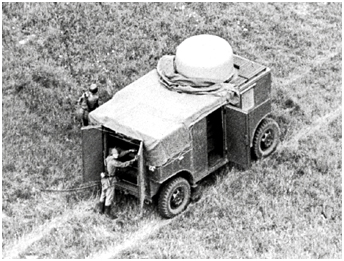
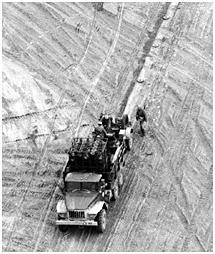 « Our aircraft were always outside the hangars so we carried our camera equipment in our aircraft helmet bags from the hangars to the aircraft and usually wore our helmets to the aircraft.
As a photography lover, it was a privilege to have photographic equipment that I personally could not afford. We used Nikon F camera bodies with or without motor drives, 50mm, 135mm,
500mm, and 1000mm lenses, plus unlimited amounts of Kodak Tri-X black and white and Ektachrome color film. Our onsite USMLM photo processing laboratory completed the job and we could
get film developed within hours in a rush. USMLM's wide range of camera equipment, and especially our quick turnaround photographic laboratory, plus the experienced USMLM officers who
were quick at military equipment identification, may well have been the deciding factors for USCOB agreeing to our joint LARKSPUR operations and reports. USCOB still retained program
ownership and got first credit for outstanding reports. However, overall results were much better, more responsive, and we produced a very large number of Intelligence Information Reports
(IIR) that helped greatly in satisfying the American intelligence community's requirements.
We removed the Beaver's upper trapezoidal windows from the rear doors for several reasons. First, there was a firm mandate to minimize dropping any equipment from the aircraft while doing
our "wing over" at 45-degree-plus angles as we circled over targets for the best shots. Typically, SFC St. John and I sat in the back, each looking out one side for designated targets
that had outstanding intelligence requirements from myriad intelligence agencies, plus always seeking targets of opportunity.
Generally, the Soviets and East Germans paid little attention to us; however, if we did experience any signs of hostility, we took it as an indicator that we might be observing new
equipment or something out of the ordinary. This usually just doubled our interest. On such occasions, if we had an adventurous pilot, we'd ask for a "wing over." Aerodynamics being what they are,
this maneuver resulted in the aircraft spiraling down in altitude and we would "accidently" slip below the 1000-foot above ground level (AGL) we were supposed to maintain. »
« Our aircraft were always outside the hangars so we carried our camera equipment in our aircraft helmet bags from the hangars to the aircraft and usually wore our helmets to the aircraft.
As a photography lover, it was a privilege to have photographic equipment that I personally could not afford. We used Nikon F camera bodies with or without motor drives, 50mm, 135mm,
500mm, and 1000mm lenses, plus unlimited amounts of Kodak Tri-X black and white and Ektachrome color film. Our onsite USMLM photo processing laboratory completed the job and we could
get film developed within hours in a rush. USMLM's wide range of camera equipment, and especially our quick turnaround photographic laboratory, plus the experienced USMLM officers who
were quick at military equipment identification, may well have been the deciding factors for USCOB agreeing to our joint LARKSPUR operations and reports. USCOB still retained program
ownership and got first credit for outstanding reports. However, overall results were much better, more responsive, and we produced a very large number of Intelligence Information Reports
(IIR) that helped greatly in satisfying the American intelligence community's requirements.
We removed the Beaver's upper trapezoidal windows from the rear doors for several reasons. First, there was a firm mandate to minimize dropping any equipment from the aircraft while doing
our "wing over" at 45-degree-plus angles as we circled over targets for the best shots. Typically, SFC St. John and I sat in the back, each looking out one side for designated targets
that had outstanding intelligence requirements from myriad intelligence agencies, plus always seeking targets of opportunity.
Generally, the Soviets and East Germans paid little attention to us; however, if we did experience any signs of hostility, we took it as an indicator that we might be observing new
equipment or something out of the ordinary. This usually just doubled our interest. On such occasions, if we had an adventurous pilot, we'd ask for a "wing over." Aerodynamics being what they are,
this maneuver resulted in the aircraft spiraling down in altitude and we would "accidently" slip below the 1000-foot above ground level (AGL) we were supposed to maintain. »
notes
(1)
The "local" missions on the ground that Army personnel performed consisted of monitoring H24 the area surrounding the Berlin Wall and all the
access routes leading to Berlin in order to detect warning signs and, based on events or unusual activities that had been observed,
then possibly
provide lucrative tasking for subsequent ground tours.
(2)
Once clearance was received from Heidelberg, USMLM field grade officers also began participating in the program.
 |
Operation Larkspur > Part 2 |
 |
Plan du site - Sitemap |  |
